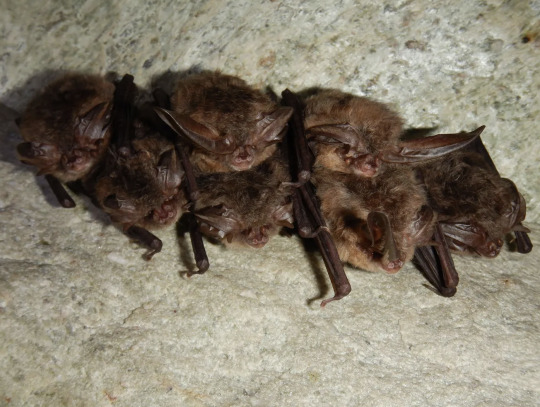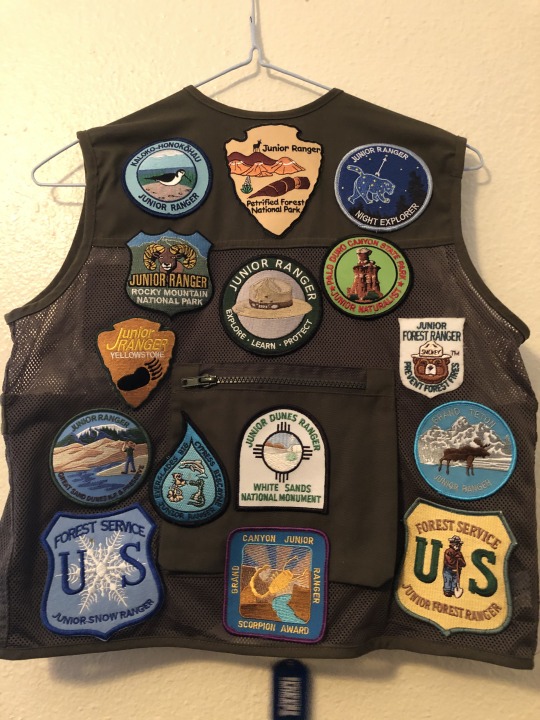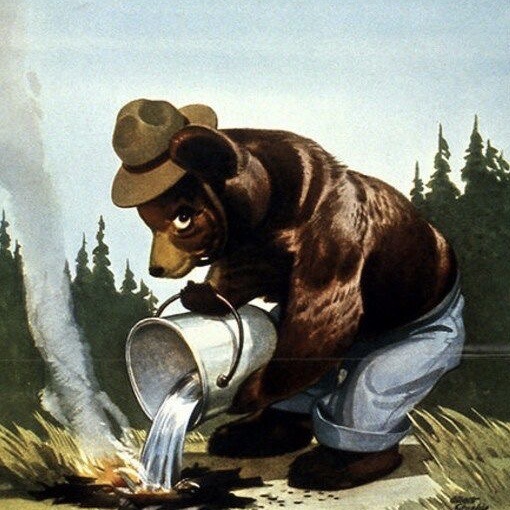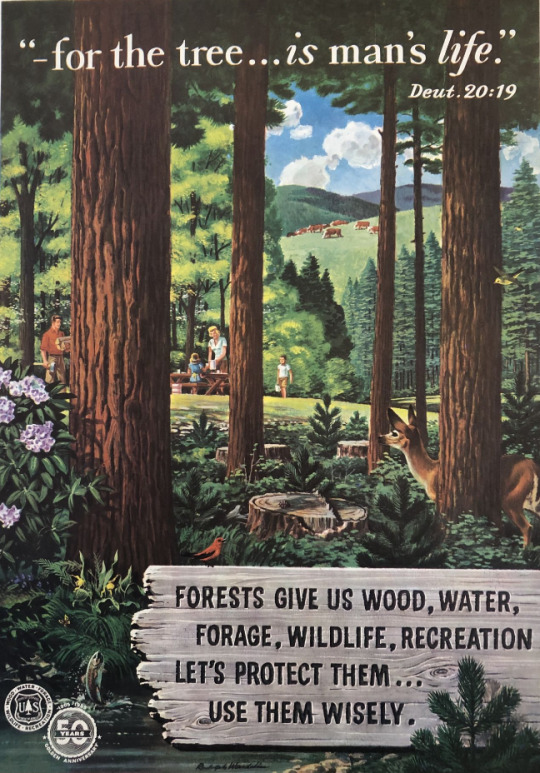#us forest service
Text
Conservation groups filed objections this week to the U.S. Forest Service’s proposed final management plan for the Grand Mesa, Uncompahgre and Gunnison national forests in western Colorado. The plan would allow commercial logging on more than 772,000 acres of public lands, including mature and old-growth trees — a 66% increase from the current forest plan.
“A sizeable area of our beloved forests could be sacrificed to commercial logging at the expense of our already dwindling wilderness areas, wildlife habitat and recreation,” said Chad Reich with High Country Conservation Advocates. “Outdoor recreation is a far larger economic driver for our communities than the local timber industry that benefits from cutting these forests. The Forest Service would’ve known that if it had conducted an economic analysis, as required by law.”
Under the proposed plan mature and old-growth forests, which store massive amounts of carbon, could be commercially logged. Forest managers would not be required to identify and protect old-growth and mature trees. Steep slopes across the forests, including Upper Taylor Canyon and Slate River Valley, could also be logged despite the high risk of severe erosion and threats to water quality.
“The proposed plan directly violates federal policy on protecting mature and old-growth trees as a cornerstone of U.S. climate action,” said Alison Gallensky, conservation geographer with Rocky Mountain Wild. “The Grand Mesa, Uncompahgre and Gunnison national forests boast the highest carbon sequestration capacity of any national forest in the Rocky Mountain region. Despite this the Forest Service has failed to ensure these vital carbon sinks aren’t logged and sold.”
Objections also challenged the Forest Service’s failure to take urgently needed climate action by prohibiting new coal leasing in the plan.
...
The Forest Service recommended adding only 46,200 acres of new wilderness area in the final plan. The community’s conservation proposal had called for more than 324,000 acres of new wilderness lands. In addition, the Gunnison Public Lands Initiative offered a broadly supported proposal for new wilderness and special management areas in Gunnison County that was mostly excluded.
...
“Community members proposed special management area designations to protect pristine forestlands in the North Fork Valley from logging and oil and gas drilling,” said Peter Hart, legal director at Wilderness Workshop. “The Forest Service ignored those proposals and chose not to protect those areas in the new plan.”
The groups also raised concerns about the plan’s failure to address the myriad needs of plants and animals that depend on the forests.
“Over 20 years ago Colorado Parks and Wildlife reintroduced Canada lynx to the San Juan Mountains,” said Rocky Smith, a long-time forest management analyst. “This is a great source of pride for wildlife lovers in this state. Lynx are federally threatened and depend on mature forests with large trees. This plan allows for logging that could easily degrade or destroy much of the best habitat for lynx and their main prey, snowshoe hares, and undermine Colorado’s hard work to reestablish and maintain a viable lynx population.”
The Grand Mesa, Uncompahgre and Gunnison national forests also provide habitat for the iconic bighorn sheep and lesser-known species like the Grand Junction milkvetch and the Tundra buttercup. These species, among others, need special designation the Forest Service grants to plants and animals when there is concern about their ability to survive in the area. Many struggling plants and animals were left off the list in the proposed final plan.
“Without the species of conservation concern designation the Forest Service has no obligation to make sure the plants and animals continue to exist locally,” said Chris Krupp, public lands attorney with WildEarth Guardians. “In many cases, the agency decided not to designate wildlife, plants or fish merely because it had no data on their population trends. Without species of conservation concern designation, the number of bighorn sheep in GMUG could dwindle down to almost nothing and the agency wouldn’t have to do anything about it.”
#ecology#enviromentalism#old growth forest#colorado#us forest service#lynx#bighorn sheep#grand mesa#Uncompahgre#gunnison#national forest
496 notes
·
View notes
Text
FINALS


#smokey bear#smokey the bear#us forest service#evan buckley#evan buck buckley#buck buckley#911#911 fox#911 on fox#polls#round 5
302 notes
·
View notes
Photo

US Forest Service Bell AH-1 firewatch aircraft
#US Forest Service#Bell AH-1#Aerial firefighting#Firewatch aircraft#Cobra#Helicopter#Aviation#Rotorcraft#USFS Helicopter
92 notes
·
View notes
Text

A Forest Ranger inspects the damages caused by a historic windstorm.
Siuslaw National Forest, Oregon
1962
#vintage camping#campfire light#oregon#siuslaw national forest#history#hiking#us forest service#outdoors#trees#1960s
130 notes
·
View notes
Text
🎩RADDEST HAT LOSERS ROUND👒
Choose who will make it into the Loser's bracket!








#raddest hat showdown#Raddest hat showdown poll#Raddest hat showdown polls#pre poll polls#pre poll losers bracket#tumblr tournament#polls#smokey the bear#us forest service#stanley pines#gravity falls#asra#asra arcana#hat kid#a hat in time#snufkin#moomin#ainz ooal gown#overlord#woody#toy story#jarlaxle baenre#forgotten realms
132 notes
·
View notes
Text

33 notes
·
View notes
Text

Excerpt from this story from the Asheville Citizen Times:
A coalition of five conservation organizations have sued the U.S. Forest Service, alleging the 2023 management plan for the Nantahala-Pisgah national forests failed to protect the biologically diverse areas, including the habitats of federally protected bat species, as the plan expanded logging practices in the more than 1 million acres of national forests.
The Southern Environmental Law Center filed the lawsuit against the U.S. Forest Service on the behalf of The Center for Biological Diversity, Defenders of Wildlife, MountainTrue and SierraClub in the U.S. District Court for the Western District of North Carolina in Asheville April 19.
The Pisgah and Nantahala national forests cover more than a million acres of mountainous terrain in Western North Carolina. The two are the largest of the state’s four national forests and portions of the forests are open to timber harvesting, hiking, fishing, hunting, paddling, horseback riding and other activities.
In 2023, the U.S. Forest Service released a new management plan for the two forests. The decade-long revision process on the Nantahala-Pisgah management plan — which will guide management for how much can be logged and how much of the land is protected, as well as many other forest uses, for the next 10-15 years — has been plagued with conservation group concerns about the long-term impacts of expanded logging practices.
The lawsuit alleges the Forest Service worked with "inaccurate and incomplete" information during the approval of the management plan violating the Endangered Species Act.
"The Forest Service ignored the best available science and withheld critical information from the Fish and Wildlife Service, which oversees endangered species protection,” Josh Kelly, public lands field biologist for MountainTrue, wrote in a news release.
4 notes
·
View notes
Text
Haylan Makes Adventure
I know this space is called Haylan Makes Stuff, but Stuff isn’t the only thing you can make; I’ve also made plenty of adventures and memories. I work as a seasonal park ranger, and go to as many sites as I can. Where available, I do two things; buy a sew-on patch, and complete the Junior Ranger program where it’s available. When you do, you get a free wood/plastic badge or patch, and that’s the only way you can get those items.

To show off my badges and patches of both kinds, I sew them onto flags every January. Junior Ranger programs usually consist of a workbook to complete, sometimes an activity or ranger talk.

When I work as a park ranger one of my favorite things to do is Junior Ranger for kids, and I’ve been lucky enough to create a full program for one Forest. I have a few of my earnings on a Junior Ranger vest, which is fun to wear during activities with the kids.

Anyone can do Junior Ranger, no matter your age. On duty, my oldest Junior Ranger was 88, and the youngest was 11 months old. Some places have different books/badges available, like Senior Ranger for adults, or Junior Angler, Night Sky, etc. Screw Pokemon, I gotta collect all these.

The hardest program goes to Bandelier; it took two adults to do it and we still struggled! Did you know about Junior Ranger? Do you have a favorite? Do you collect anything while you travel?
#national park service#NPS#US Forest Service#USFS#forest service#park ranger#junior ranger#patch collection#park patches#travel collection#make adventure#make memories#national parks#find your park
19 notes
·
View notes
Text
I think working for the us forest service for a summer would fix me
3 notes
·
View notes
Text
President Biden signed into existence the 917,618 acre Baaj Nwaavjo I’tah Kukveni – Ancestral Footprints of the Grand Canyon National Monument. The new national monument covers three tracts of land important to indigenous people in Arizona.
Nearly 5 million people visit the Grand Canyon each year, but few are aware that the site has been sacred to Indigenous peoples in the region since time immemorial — and that the national park designation of the region essentially kicked them off their homelands a century ago.
On Tuesday, President Biden recognized this history by designating the nearly one million-acre region including the Grand Canyon and its surrounding areas as the Baaj Nwaavjo I'tah Kukveni – Ancestral Footprints of the Grand Canyon National Monument in Arizona. The announcement follows a 15-year endeavor from a coalition of tribes to protect the region from uranium mining that has polluted the Colorado River. Baaj Nwaavjo means "where tribes roam" for the Havasupai Tribe, while I'tah Kukveni translates to "our ancestral footprints" in Hopi.
[ ... ]
Former President Barack Obama previously banned new uranium mines in the Grand Canyon area in 2012, but his policy was set to expire later this year. This is the fifth new national monument established by the Biden administration to protect the country's natural landscapes, following the designation of the Avi Kwa Ame national monument in Nevada earlier in 2023.
Republicans, of course, don't like it.
The new designation permanently protects the region from uranium mining, which Republican leaders were quick to oppose, sending a letter to Biden claiming that the protections created for the Grand Canyon would cause the U.S. to over-rely on foreign countries like Russia for uranium. However, The Guardian reported that advocates say the region only contains some 1% of the country's uranium reserves and that uranium is best mined elsewhere.
Contrary to what Republicans and far right media may claim, acreage for the Baaj Nwaavjo I’tah Kukveni was already in federal hands and does not represent a grab of state, tribal, or private lands. Amber Reimondo at Grand Canyon Trust writes...
National monument designations only apply to federally managed lands. The Baaj Nwaavjo I'tah Kukveni – Ancestral Footprints of the Grand Canyon National Monument designation thus adds a layer of protection to lands already managed by the U.S. Forest Service and U.S. Bureau of Land Management. No private, state, or tribal lands are included in the monument.
This added layer of protection is incredibly popular with the public. The monument has broad support across the Grand Canyon state.
[ ... ]
Recent polling shows that 75 percent of Arizona voters support designating lands immediately outside Grand Canyon National Park as a national monument to protect clean water supplies and Native American sites.
The three components of the Baaj Nwaavjo I'tah Kukveni are outlined in green on this map.

#baaj nwaavjo i'tah kukveni – ancestral footprints of the grand canyon national monument#indigenous rights#native americans#arizona#joe biden#us forest service#bureau of land management#conservation#the environment#uranium mining#colorado river
6 notes
·
View notes
Text
no no, y’all don’t understand, cause when I say “forest ranger” I ain’t talking about a d&d character or some genshin impact thing no, im talkin about a FOREST RANGER! I’m talkin Smokey the bear bitches

2 notes
·
View notes
Text
More than 30 wildlife conservation groups today urged the U.S. Forest Service to prohibit Idaho from paying private contractors to shoot wolves from aircraft in national forests in central and southeastern Idaho. The Idaho Wolf Depredation Control Board recently approved the controversial predator control measure.
Specifically, today’s letter asked the Forest Service to grant a 2023 petition from the Center for Biological Diversity. The petition explained that gunning down wolves from helicopters risks harm to other wildlife like grizzly bears and Canada lynx, as well as public safety and wilderness values.
If the Forest Service fails to promptly grant the petition, the groups may consider legal action in federal court.
“Recreationists should not have to worry about their safety while enjoying our public lands,” said Christine Gertschen, co-director of the Conservation Connection Foundation.
“Aerial gunning is dangerous for all concerned, especially for our native wildlife.”
The Idaho Wolf Depredation Control Board is funded primarily by tax dollars. The proposals approved for funding could allow aerial gunning across much of Idaho, including lands in the Caribou-Targhee National Forest, Boise National Forest, Salmon-Challis National Forest, Sawtooth National Forest and Payette National Forest.
“Aerial gunning prioritizes wolf killings over the health and safety of our shared forests,” said Sasha Truax, presidents of Teens Restoring Earth’s Environment. “It is a twisted abuse of public funding and its continuance exposes the brutality of wolf management on public lands. It must be stopped.”
#ecology#enviromentalism#let wolves live#wolves#idaho#Idaho depredation control board#us forest service#wildlife conservation#Aerial gunning#Aerial hunting#Helicopter hunting#public lands#national forest#Private contractors#Caribou-Targhee National Forest#Boise National Forest
6 notes
·
View notes
Text
Quarter Final - Other Fandoms


#galo thymos#promare#Promare galo#galo promare#smokey bear#smokey the bear#us forest service#only you can prevent forest fires!!!#polls#round 3
100 notes
·
View notes
Text

Department of Agriculture poster. These were hung in ranger stations, schools, and around public parks.
1955
#vintage camping#campfire light#dept of agriculture#50s#us forest service#history#camping#fire safety#travel
351 notes
·
View notes
Text
🎩Raddest Hat Battle👒
Link's Rubber Helm from Breath of the Wild vs Smokey the Bear from U.S. Forest Service Propaganda
Round 1 Side 3B


#raddest hat showdown#Raddest hat showdown polls#Raddest hat showdown poll#raddest hat showdown round 1#round 1 Side 3B#tumblr tournament#polls#link#loz breath of the wild#breath of the wild#botw#botw link#smokey the bear#us forest service#wildfire prevention
18 notes
·
View notes
Photo

April 05, 1933-- FDR creates Civilian Conservation Corps
"On April 5, 1933, President Franklin D. Roosevelt establishes the Civilian Conservation Corps (CCC), an innovative federally funded organization that put tens of thousands of Americans to work during the Great Depression on projects with environmental benefits.
In 1932, FDR took America’s political helm during the country’s worst economic crisis, declaring a “government worthy of its name must make a fitting response” to the suffering of the unemployed. He implemented the CCC a little over one month into his presidency as part of his administration’s “New Deal” plan for social and economic progress. The CCC reflected FDR’s deep commitment to environmental conservation. He waxed poetic when lobbying for the its passage, declaring “the forests are the lungs of our land [which] purify our air and give fresh strength to our people.”
The CCC, also known as “Roosevelt’s Tree Army,” was open to unemployed, unmarried U.S. male citizens between the ages of 18 and 26. All recruits had to be healthy and were expected to perform hard physical labor. Blacks were placed in de-facto segregated camps, although administrators denied the practice of discrimination. Enlistment in the program was for a minimum of 6 months; many re-enlisted after their first term. Participants were paid $30 a month and often given supplemental basic and vocational education while they served. Under the guidance of the Departments of the Interior and Agriculture, CCC employees fought forest fires, planted trees, cleared and maintained access roads, re-seeded grazing lands and implemented soil-erosion controls. They built wildlife refuges, fish-rearing facilities, water storage basins and animal shelters. To encourage citizens to get out and enjoy America’s natural resources, FDR authorized the CCC to build bridges and campground facilities. From 1933 to 1942, the CCC employed over 3 million men.
Of Roosevelt’s many New Deal policies, the CCC is considered by many to be one of the most enduring and successful. It provided the model for future state and federal conservation programs. In 1942, Congress discontinued appropriations for the CCC, diverting the desperately needed funds to the effort to win World War II."
- History.com
This Civilian Conservation Corps Ring from 1940 can be found in the online collection of the National Museum of Forest Service History.
#this day in history#ccc#Civilian Conservation Corps#US Forest Service#Forest Service#Museums#history museums#PastPerfect#PastPerfect Online#Online Museum Collections#Montana Museums#US Museums#history#US History
5 notes
·
View notes